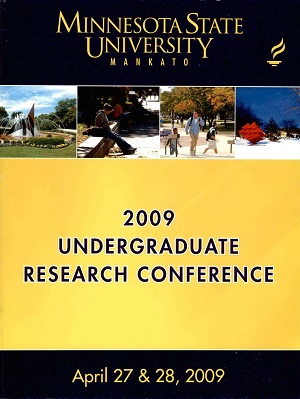Mycobacterium paratuberculosis Carbon Catabolism in Nutrient-Rich and Nutrient-Poor Environments
Location
CSU Ballroom
Start Date
28-4-2009 10:00 AM
End Date
28-4-2009 12:00 PM
Student's Major
Biological Sciences
Student's College
Science, Engineering and Technology
Mentor's Name
Timothy E. Secott
Mentor's Department
Biological Sciences
Mentor's College
Science, Engineering and Technology
Description
Mycobacterium paratuberculosis (Mpt) is an acid-fast bacillus that causes Johne's disease, a chronic enteritis of cattle. This disease is a significant cause of economic loss for the diary industry. Normally, Mpt is transmitted from mother to calf, but it has been shown that it can survive outside the host. How the organism is able to survive outside the host is unclear. The purpose of this study was to investigate changes in the physiology of Mpt, as indicated by changes in its catabolic activity, that could enable the organism to survive in the environment. PAMSUM-8 and PAMSUM-9 strains of Mpt were grown in rich medium (Middlebrook 7H9) to represent nutrient conditions in the host, and minimal medium (Sauton's broth) to represent nutrient outside the host. Strains grown separately in each medium were used to inoculate BIOLOG microplates to identify carbon sources used by Mpt. Both strains utilized dextrin, regardless of original growth medium. Overall, Mpt grown in Sauton's broth used fewer carbon sources. However, Mpt grown in this medium utilized four carbon sources (succinic acid, formic acid, gentiobiose, and D-glucuronic acid) that were not catabolized by Mpt grown in rich medium. In addition, the catabolic potential in both media varied between the strains studied. Future experiments will explore the potential role of each of the four unique substrates utilized by Mpt grown in minimal medium.
Mycobacterium paratuberculosis Carbon Catabolism in Nutrient-Rich and Nutrient-Poor Environments
CSU Ballroom
Mycobacterium paratuberculosis (Mpt) is an acid-fast bacillus that causes Johne's disease, a chronic enteritis of cattle. This disease is a significant cause of economic loss for the diary industry. Normally, Mpt is transmitted from mother to calf, but it has been shown that it can survive outside the host. How the organism is able to survive outside the host is unclear. The purpose of this study was to investigate changes in the physiology of Mpt, as indicated by changes in its catabolic activity, that could enable the organism to survive in the environment. PAMSUM-8 and PAMSUM-9 strains of Mpt were grown in rich medium (Middlebrook 7H9) to represent nutrient conditions in the host, and minimal medium (Sauton's broth) to represent nutrient outside the host. Strains grown separately in each medium were used to inoculate BIOLOG microplates to identify carbon sources used by Mpt. Both strains utilized dextrin, regardless of original growth medium. Overall, Mpt grown in Sauton's broth used fewer carbon sources. However, Mpt grown in this medium utilized four carbon sources (succinic acid, formic acid, gentiobiose, and D-glucuronic acid) that were not catabolized by Mpt grown in rich medium. In addition, the catabolic potential in both media varied between the strains studied. Future experiments will explore the potential role of each of the four unique substrates utilized by Mpt grown in minimal medium.
Recommended Citation
Russell, Eric and Amanda Vaske. "Mycobacterium paratuberculosis Carbon Catabolism in Nutrient-Rich and Nutrient-Poor Environments." Undergraduate Research Symposium, Mankato, MN, April 28, 2009.
https://cornerstone.lib.mnsu.edu/urs/2009/poster-session-C/16




